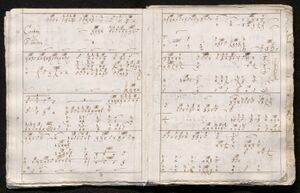Franz Tunder
Franz Tunder
Analysis
The organ chorale works of Franz Tunder can be divided into four categories[1]:
- Verse cycles with separate verses - Jesus Christus, unser Heiland
- Continuous Verse cycles - Auf meinen lieben Gott
- Choral ricercare - Jesus Christus, wahr' Gottes Sohn
- Choral Fantasie (the rest of the surviving compositions)
Works

Except for one work, all remaining pieces by Franz Tunder only occur in one early source. The sources of Tunder's organ music are in three main categories:
a collection of manuscripts in the Rätsbucherei, Lüneburg.
- The Lüneburg Tablatures, including Mus.ant.pract. K.N. 209.
- The Pelplin Tablatures, a collection of manuscripts from the Pelplin Monestary.
- The Canzona by Tunder is located in a manuscript currently housed in the Universitetsbibliotek, Uppsala.
Note: numbers in brackets are written in the manuscript by a librarian.
| Source(s) | Title | Notes | Incipit |
|---|---|---|---|
| D-Lr Mus.ant.pract. K.N. 209 P486-489 | [34] Auff meinen Lieben / Gott / Auff 2 Clavier / Manualiter / F. Tunder |  | |
| PL-PE 306 (Tabulatura organowa Tom. III) P282-293 | Christ lag in / todtes banden / Frans: Tunder: |  | |
| D-Lr Mus.ant.pract. K.N. 207/17/1 P428-431
D-Lr Mus.ant.pract. K.N. 209 P644-649 |
[207/17/1:] [13] Herr Gott / dich loben wir p / auff 2. Clav. / Franciscus Tunder. |  | |
| D-Lr Mus.ant.pract. K.N. 209 P474-477 | [30] Indich habichge / hoffet Herr. / Auff 2. Clavier. / F. Tunder. |  | |
| D-Lr Mus.ant.pract. K.N. 209 P562-565 | [48] Jesus Christus / Unser Heÿland. / F. T. |  | |
| D-Lr Mus.ant.pract. K.N. 209 P470-473 | [29] Jesus Christus / wahr Gottes Sohn / F: Tunder |  | |
| D-Lr Mus.ant.pract. K.N. 209 P634-639 | [72] Komm Heÿliger / Geist Herre Gott / Auff 2 Clauier / Franciscus: Tunder: Ped: |  | |
| PL-PE 305 (Tabulatura organowa Tom. II) P288-294 | Was kan uns / kommen an fur: / Noth / 2 Clav: Ped: / Frans: Tunder. | Pelplin/C-Major version, fragment |  |
| D-Lr Mus.ant.pract. K.N. 209 P612-621 | [65] Waß kan vns / kommen an / für noth / Auf 2. Clauier. / F. Tunder. Ped: | Lüneburg/F-Major version | |
| D-Lr Mus.ant.pract. K.N. 207/16 F3v-4r | Praeludium / [3] / Franc: Tunder. | F-Major |  |
| D-Lr Mus.ant.pract. K.N. 207/16 F2v-3r | Praeludium / [2] / Franc. Tunder. | G-Minor |  |
| D-Lr Mus.ant.pract. K.N. 207/16 F4v-5r | Praeludium / Franc. Tunder. [4] | G-Minor |  |
| D-Lr Mus.ant.pract. K.N. 207/16 F5v-6r | Praeludium [5] / Franc: Tunder | G-Minor |  |
| D-Lr Mus.ant.pract. K.N. 207/15 P909-910 | [55] Praeludium / F. Tund: | G-Minor |  |
| S-Uu Ms. Ihre 285 P50-52 | [20] Cantzon / F: Töndern | On a theme by Francesco Della Porta |  |
Other theorized works
Two chorale fantasias from the Pelplin Tablatures are theorized to be by Franz Tunder by Klaus Beckmann, despite the composer "H.M.T." being written[2]. He also theorized that the anonymous Magnificat octavi toni (also a chorale fantasia) from the Zellerfeld Tablatures no.1 is by Tunder[Citation needed].
The first praeludium in D-Lr Mus.ant.pract. K.N. 207/16, which is anonymous, has been described as being reminiscent of Tunder[3].
References
Schumacher, Claudia (editor). Franz Tunder: Sämtliche Orgelwerke. Mainz: Schott, 2019.
- ↑ Beckmann, Klaus, Die Norddeutsche Schule. Teil II: Blütezeit und Verfall. Mainz: Schott, 2009. 277
- ↑ Beckmann, Klaus (editor), Zwei Choralfantasien: Allein zu dir, Herr Jesu Christ ; Ein feste Burg ist unser Gott. Wiesbaden: Breitkopf & Härtel, 1991.
- ↑ Organum IV vol.10